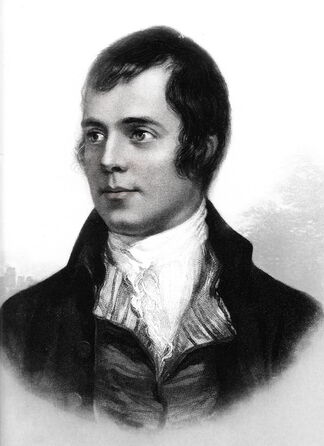
Robbie Burns
The Scottish Bard
January is a month for Robbie Burns. We start the month with singing Auld Lang Syne – composed by Robbie Burns - and then close out the month with Burn’s Night on 25th January. Burns Night is a celebration of his birthday and his poems and songs, with fine Scottish fare like haggis, and all washed down with plenty of fine Scottish Whisky.
If you have never attended a Burns Night celebration, you have missed out big time. And I recommend you either organise one, or find one in your area to go to. I held a Burns Night Whisky Tasting (with Haggis, of course) last year and will be doing something along those lines this year.
Anyway, I feel it is appropriate to create this blog entry about the Man, the Myth and the Legend! Who was he and what was he? What is his Legacy? What was his life like?
Robbie Burns the Farmer
Robert Burns was born on 25 January 1759, in the village of Alloway in Ayrshire. The eldest of 7 children, his father was a farmer with a strong belief in education. Despite relative poverty, Robbie had a private tutor called John Murdoch. When his father died in 1784, Robbie and his brother Gilbert took over the farm, but within a few years they were in financial trouble. So, he turned to his literary education as a source of income.
Robbie Burns the Poet and Songwriter
Burns is known the world over as a leading poet, yet much of his prodigious output consisted of songs. Burns lived a short yet productive life, squeezing much of his major work into a mere decade, from the publication of Poems, Chiefly in the Scottish Dialect in Kilmarnock in 1786 to his death in Dumfries 10 years later.
Much of this energy was spent collecting, reworking, and writing new lyrics for existing songs. Burns was one of the leading songsmiths of his day with an output to rival Lennon and McCartney (although he didn’t actually write the music). Burns was the main contributor to editor James Johnson’s Scots Musical Museum, a leading collection of Scots songs from the period.
Robbie Burns the Author of Auld Lang Syne?
Well, not exactly! Known nowadays by most as the song we sing at New Year (Hogmanay in Scotland), and one of the best-known Burn’s poems/songs, it is actually one of the Songs that Burns “improved” but did not create. Burns built upon earlier versions of the poem, which included a version ascribed to Sir Robert Aytoun and another to Edinburgh poet Allan Ramsay. But there is no doubt that Burns made the song a set piece for New Year, and more. Did you know that the song was the National Anthem for Korea and the Maldives? And is a song sung at graduation in Japan? ‘Hotaru no Hikari’ is also used to signal closing time in some Japanese stores. These Scots get everywhere!
Auld Lang Syne’ was a favourite of Union forces in the American Civil War and was also sung by troops in the First World War during the famous Christmas truce of 1914.
Robbie Burns the Patriot Scotsman
Burns is celebrated as Scotland’s national bard, and the ‘cult of Burns’ is an integral part of Scottish cultural identity. Burns became the leading voice in the ‘Vernacular Revival’ of Scots language poetry in post-Union Scotland.
As a self-professed patriot and ‘sentimental Jacobite’, Burns venerated national heroes such as Robert the Bruce, William Wallace and Bonnie Prince Charlie. He played a central part in the ‘invention’ of Scottish national identity in the Romantic period and beyond, from the ‘romanticisation’ of the Highlands through to the making of national symbols out of whisky and haggis. And check out his rousing patriotic anthem ‘Scots Wha Hae’!
His name was even touted during the independence vote in Scotland, claiming independence would have had his vote!
Robbie Burns the Womaniser
Burns was famed for his weakness for women. He fathered some 13 children to at least five different women. His 13th child was born on the day of his funeral. The majority of his children were born out of wedlock, although some were legitimised when Burns finally married Jean Armour. When they first tried to marry, Armour’s family tore up the contract. Outraged, Burns supposedly tried to flee to the Caribbean with another woman called Mary Campbell (‘Highland Mary’), but was eventually convinced to stay in Scotland as by then his poems were beginning to attract plenty of attention.
He had a famous affair with Agnes McLehose, or ‘Clarinda’, which produced a renowned series of love letters as well as one of the finest love songs ever written, ‘Ae Fond Kiss’. However, in this case his love didn’t stop him from seducing McLehose’s maid, Jenny Clow, who also had a child to the poet in 1788.
Robbie Burns the Whisky Tax Collector
Like many artists, commercial success comes only after death and during his life, Burns spent more money than he made. At the age of 29, probably due to low income from his writing and high costs of maintaining his many children, he decided to put his education to work as an exciseman, or a gauger, or a tax collector. An exciseman was employed by the government to ensure that people paid their taxes, particularly related to alcohol.
In September 1789, he was appointed Excise Officer for Dumfries. Later, in February 1792 he was promoted to the Dumfries Port Division, an appointment that carried a salary of £50 per year. Giving him a comfortable life for the first time in his life.
Robbie Burns Went To An Early Grave
Robbie Burns died at the very young age of 37, in 1796, from a rheumatic heart condition. In the latter years of his life, his work attendance suffered due to ill health and his salary was cut to £50 per year. He died poor.
Robbie Burns - His Legacy
On 25 January 1859, on the centenary of his birth, memorial events were held all over Scotland, and now Burns Night is virtually a national holiday! In honour of their greatest poet, Scots sing songs, read aloud, drink plenty of whisky and address Scotland’s national dish using Burns’ own poem ‘Ode To a Haggis’. Burns’ legacy lives on across Scotland and around the world – in many countries it’s now traditional to sing ‘Auld Lang Syne’ when seeing in the new year.
Although most closely associated with Scotland (and even the stereotypical trappings of Scottish identity), Burns’s reputation is international. There are statues of Burns all over the world, in places as far afield as North America and New Zealand. His likeness has appeared on bank notes, postage stamps, and Coca Cola bottles, and an edition of his poems has even been sent into space.
Burns has had many admirers, from other poets and writers through to world leaders. For example, US president Abraham Lincoln was a big fan of Burns and could recite lines of his poems by heart.
